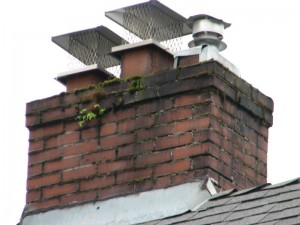
by Mike O'Mara | Aug 31, 2015 | Chimney Maintenance, fire safety

Not sure what a damper is or what it does? Weststar Chimney Sweeps is here to help.
At Weststar Chimney Sweeps, we are often asked by our customers to explain damper locks and why they are necessary. These questions typically come from those who have just had a home inspected for real estate purposes and have been told by the home inspector that they need to install damper locks to be compliant with the California Uniform Building Code. We know exactly how to keep you under compliance with this code, and our Chimney Safety Institute of America (CSIA)-certified chimney technicians can install damper locks in your chimney system. We would like to tell you more about damper locks to inform you of this important and necessary safety component.
What exactly is a damper lock?
Also known as a damper clamp or a damper stop, a damper lock is a small C-clamp or steel beam clamp that serves to keep the damper in a fully open position.
Why do I need a damper lock?
According to the California Uniform Building Code, damper locks are required to be equipped on dampers for systems that vent any type of gas appliance. Whenever you burn a fire in your gas appliance, the damper must be locked open for safety reasons. This can prevent carbon monoxide from being forced back into your home. If the damper is closed, this poisonous gas has no way to exit out of the chimney. Without carbon monoxide detector alarms installed in your home, you and your family could easily become seriously ill from carbon monoxide poisoning as this toxic gas is odorless and tasteless.
Why are damper locks only required for gas appliances?
If you forget to open your damper when you are burning wood, the problem becomes obvious when the room quickly fills with smoke after lighting the fire. As we mentioned earlier, there are no obvious signs for not opening the damper during a gas-fueled fire. This is why the California Uniform Building Code has required that the damper be locked in a fully-open position. You will be protected from the dangers of carbon monoxide if you forget to open the damper or if your gas appliance is turned on accidentally.
How can I prevent heat loss from my home when the damper must be locked fully open?
To help keep the heated air from your gas fire inside your home, Weststar Chimney Sweeps can install glass doors in front of your fireplace. However, you should keep in mind that if you have a prefabricated or factory built fireplace, glass doors may not be an option for safety reasons.
Have more questions about damper locks? Contact us at Weststar Chimney Sweeps so that we can help you be compliant to this important state building code.
by Mike O'Mara | Jan 7, 2015 | Chimney Cap Choices
One of your best defenses against water penetration and animal invasions of your chimney, a chimney cap sits on top of your chimney’s opening. With several different types of chimney caps available, how do you know which cap is the right fit for the flue of your chimney? At Weststar Chimney Sweeps, we are experienced with fitting all types of chimney caps, even customized caps, and we know the importance of proper installation. We would like to tell you a bit about the different kinds of chimney caps and what you should know about selecting the right kind for your chimney to prevent damaging water leaks.

The main thing to consider when deciding which chimney cap is right for your chimney is the shape of your flue. Chimney caps come in different shapes to fit each type of flue. These shapes include:
ROUND FLUES
Whether you have a clay, masonry, or metal flue, you can find a round chimney cap that can either attach the the outside of the flue or slip inside the flue. Round chimney caps are made from an assortment of materials including copper, stainless steel, and galvanized steel. Some round flue liners require chimney caps that must be inserted inside the chimney flue, such as round flexible flue liners and round solid pack flue liners.
SQUARE AND RECTANGULAR FLUES
The most commonly shaped flue, square and rectangular chimney caps can be attached to the flue, or, if you have a chimney crown, there are chimney caps in these sizes that can attach to the crown. Made from the same metals as the round chimney caps, the Chimney Safety Institute of America (CSIA) recommends you choose a chimney cap constructed from a sturdy, durable, and rust- and corrosion-resistant material to ensure a long-lasting cap. For chimney caps that attach to a chimney crown, you will need to choose from top mounted chimney caps.
OVAL FLUES
Unless you have a custom-shaped oval chimney cap made for you by our technicians at Weststar Chimney Sweeps, you will need to look at rectangular shaped chimney caps that will cover the exterior of your flue.. When you look inside this type of cap, you can see how the corner tabs or interior ledges will accommodate oval flues.
There are other considerations other than preventing water leaks to think about when choosing a chimney cap. These include:
MESH SPARK ARRESTOR
To prevent animals from entering your chimney to take up a new residence and to keep sparks from flying out of your chimney and possibly starting a fire, your chimney cap should be equipped with wire mesh sides. Be sure the mesh openings are between ¾ to ½ inches in size to keep animals out, to contain large pieces of hot debris and ashes, and to allow toxic gases to escape.
COMBINATION OF A CHIMNEY CAP AND DAMPER
You can now find top sealing chimney caps that do double duty as a protective cap and as a damper. Perfect for new home constructions and for older chimneys in need of numerous repairs, the damper is located on the cap. When it is sealed closed, the air loss from your home is reduced by 90%. When the damper is opened, the wire mesh on the chimney cap protects your chimney from invading animals and prevents stray sparks from exiting.
Want to know more about the different types of chimney caps? Contact Weststar Chimney Sweeps today to talk to our expert staff about your many options.


